An Evaluation Framework for Regional Ecological Security Pattern Quality: A Case Study of the Taihang–Qinling Intersection Zone, China
Abstract
1. Introduction
2. Materials and Methods
2.1. Study Area
2.2. Research Methods
2.2.1. Identification of ESP
- (1)
- Identification of Ecological Sources
- (2)
- Construction of Ecological Resistance Surfaces
- (3)
- Extraction of Ecological Corridors and Ecological Strategic Points
2.2.2. Analysis of Ecological Network Topology Structure
- (1)
- Construction of Topology Network
- (2)
- Division of Ecological Regions
2.2.3. Evaluation of ESP Quality
2.3. Data Sources
3. Results
3.1. Spatiotemporal Evolution Characteristics of ESP
3.1.1. Ecological Sources
3.1.2. Ecological Resistance Surfaces
3.1.3. Ecological Corridors and Ecological Strategic Points
3.1.4. Ecological Network Topology Structure
3.2. Spatiotemporal Evolution Characteristics of ESP Quality
3.2.1. Overall Characteristics
3.2.2. Local Characteristics
4. Discussion
- (1)
- Taihang ecological barrier region: Key ecological sources in this region are relatively concentrated and large in area, whereas general ecological sources are dispersed around these core patches. The fragmentation of ecological sources remains low. A high density of general ecological corridors, interwoven with key ecological corridors, effectively enhances network connectivity. Numerous ecological pinch points play a critical role in maintaining ecological network connectivity and ecosystem stability. Ecological barrier points are few and mainly situated near major transportation lines and residential areas, causing only minor interference to the ecosystem. Therefore, the Taihang Mountains region is suitable as an ecological barrier region. To safeguard and enhance ecosystem service functions, future measures should include strict enforcement of ecological protection red lines, prioritizing key ecological sources for protection, and restricting development activities that could negatively affect the ecological environment. Establishing a comprehensive ecological monitoring system is also essential for tracking dynamic changes and consolidating the foundation of ecological security. Special attention should be paid to the Wangwu Mountains region in the north. Additionally, ecological restoration projects—such as establishing buffer zones along transportation corridors and ecological enhancement near residential areas—can mitigate the negative effects of ecological barrier points and promote the sustained strengthening of barrier functions.
- (2)
- Songji ecological restoration region: Key ecological sources in this region are scattered in small, isolated patches, and general ecological sources are also widely separated. The fragmentation of ecological sources is very high. There are a few key ecological corridors, and many are narrow and discontinuous, resulting in poor connectivity of the general ecological corridors. Severe ecological degradation around ecological pinch points hinders the effective performance of ecosystem functions. Numerous ecological barrier points are concentrated in urban expansion areas, mining zones, and around transportation hubs, causing significant ecological disturbance. Therefore, the Songji Mountains region is suitable as an ecological restoration region. Restoration priorities should include the consolidation and expansion of ecological sources through afforestation and restoration of degraded forests, as well as enhancing source connectivity. Improving ecological corridor connectivity will require corridor restoration and reconstruction, bridging discontinuities, widening narrow segments, and building wildlife passages. Strengthening urban green infrastructure, building urban greening systems, increasing efforts in mine rehabilitation, and promoting green mining are necessary for gradually restoring the regional ecosystem and reestablishing ecological balance.
- (3)
- Qinling ecological conservation region: Key ecological sources in this region are distributed in continuous patches with strong integrity and connectivity. Key ecological corridors align with the mountain ranges, forming a stable and well-connected network. Ecological pinch points are reasonably distributed, supporting the stable functioning of the ecosystem, while ecological barrier points are extremely limited and exert minimal disturbance. Therefore, the Qinling Mountains region is suitable as an ecological conservation region. Future strategies should focus on combining strict ecological protection with moderate, sustainable development, leveraging the region’s rich ecological resources for activities such as ecological education and tourism. These actions can raise public awareness of ecological protection and facilitate the sustainable use of ecological resources. It is also necessary to ensure the conservation of “stepping stone” patches, thereby strengthening corridor connectivity, enhancing the functional influence of ecological sources, and promoting ongoing improvement of ecosystem service functions.
5. Conclusions
- (1)
- From 2000 to 2020, both the number and area of ecological sources increased substantially. The ecological resistance surface displayed consistently higher values in the east and lower values in the southwest, with pronounced spatial heterogeneity. The number of ecological corridors increased, whereas their average length decreased; corridors predominantly extended from northwest to southeast. Both ecological pinch points and barrier points showed significant growth.
- (2)
- From 2000 to 2020, despite the increase in the scale of ecological sources and the number of corridors, considering the comprehensive impact of multiple evaluation factors, the overall ESP quality in the Taihang–Qinling intersection zone exhibited a declining trend. The Taihang and Qinling Mountains regions also showed an overall decline, though the quality remained within a controllable range and the overall foundation was relatively sound. In contrast, the Songji Mountains region demonstrated an overall improvement in quality. However, ecological source fragmentation remained high, and the overall quality foundation was weak in this region. Consequently, the quality decline in these two larger regions drove the overall decline. Despite its improvement, the smaller Songji Mountains region could not counteract the decreasing trend in regional ESP quality or achieve fundamental improvement.
- (3)
- Based on the identified ESP and quality characteristics, an ecological protection and restoration pattern was proposed, comprising the Taihang ecological barrier region, the Songji ecological restoration region, and the Qinling ecological conservation region. Differentiated optimization strategies were developed for ecological protection and restoration in each region to promote regional ecological security.
Author Contributions
Funding
Data Availability Statement
Acknowledgments
Conflicts of Interest
References
- Yu, K. Landscape ecological security patterns in biological conservation. Acta Ecol. Sin. 1999, 19, 8–15. [Google Scholar]
- Nobel, A.; Lizin, S.; Brouwer, R.; Bruns, S.B.; Stern, D.I.; Malina, R. Are biodiversity losses valued differently when they are caused by human activities? A meta-analysis of the non-use valuation literature. Environ. Res. Lett. 2020, 15, 73003. [Google Scholar] [CrossRef]
- Wu, M.; Wu, X. Urban ecological network planning based on “eco-integrated city” concept: On the division and re-connection of ecological functions in spatial planning. City Plan. Rev. 2018, 42, 9–17. [Google Scholar]
- Peng, J.; Liu, Y.; Corstanje, R.; Meersmans, J. Promoting sustainable landscape pattern for landscape sustainability. Landsc. Ecol. 2021, 36, 1839–1844. [Google Scholar] [CrossRef]
- Willemen, L.; Barger, N.N.; Brink, B.T.; Cantele, M.; Erasmus, B.F.N.; Fisher, J.L.; Gardner, T.; Holland, T.G.; Kohler, F.; Kotiaho, J.S.; et al. How to halt the global decline of lands. Nat. Sustain. 2020, 3, 164–166. [Google Scholar] [CrossRef]
- Yi, L.; Sun, Y.; Yin, S.; Wei, X. Construction of ecological security pattern: Concept, framework and prospect. Ecol. Environ. Sci. 2022, 31, 845–856. [Google Scholar]
- Baste, I.A.; Watson, R.T. Tackling the climate, biodiversity and pollution emergencies by making peace with nature 50 years after the Stockholm Conference. Glob. Environ. Change 2022, 73, 102466. [Google Scholar] [CrossRef]
- Bryan, B.A.; Gao, L.; Ye, Y.; Sun, X.; Connor, J.D.; Crossman, N.D.; Stafford-Smith, M.; Wu, J.; He, C.; Yu, D.; et al. China’s response to a national land-system sustainability emergency. Nature 2018, 559, 193–204. [Google Scholar] [CrossRef]
- Chen, Y.; Zhang, Y.; Zhang, X.; Zhang, Y. The institutional construction of territorial spatial governance for “integrated mountains, rivers, forests, fields, lakes, grasses and deserts” in China. J. Nat. Resour. 2025, 40, 1174–1193. [Google Scholar] [CrossRef]
- Nelson, A.C.; Moore, T. Assessing urban growth management: The case of Portland, Oregon, the USA’s largest urban growth boundary. Land Use Policy 1993, 10, 293–302. [Google Scholar] [CrossRef]
- Ding, C.; Knaap, G.J.; Hopkins, L.D. Managing Urban Growth with Urban Growth Boundaries: A Theoretical Analysis. J. Urban Econ. 1999, 46, 53–68. [Google Scholar] [CrossRef]
- Opdam, P.; Steingröver, E.; van Rooij, S. Ecological networks: A spatial concept for multi-actor planning of sustainable landscapes. Landsc. Urban Plan. 2006, 75, 322–332. [Google Scholar] [CrossRef]
- Bani, L.; Baietto, M.; Bottoni, L.; Massa, R. The Use of Focal Species in Designing a Habitat Network for a Lowland Area of Lombardy, Italy. Conserv. Biol. 2002, 16, 826–831. [Google Scholar] [CrossRef]
- Ma, K.; Fu, B.; Li, X.; Guan, W. The regional pattern for ecological security (RPES): The concept and theoretical basis. Acta Ecol. Sin. 2004, 24, 761–768. [Google Scholar]
- Ye, X.; Zou, C.; Liu, G.; Lin, N.; Xu, M. Main research contents and advances in the ecological security pattern. Acta Ecol. Sin. 2018, 38, 3382–3392. [Google Scholar] [CrossRef][Green Version]
- Zhou, Y.; Feng, Z.; Lin, Q.; Wang, J.; Zhang, K.; Wu, K. Research progress on the width of ecological corridors in ecological security pattern. J. Appl. Ecol. 2025, 36, 918–926. [Google Scholar][Green Version]
- Mu, H.; Li, X.; Ma, H.; Du, X.; Huang, J.; Su, W.; Yu, Z.; Xu, C.; Liu, H.; Yin, D.; et al. Evaluation of the policy-driven ecological network in the Three-North Shelterbelt region of China. Landsc. Urban Plan. 2022, 218, 104305. [Google Scholar] [CrossRef]
- Wei, Q.; Halike, A.; Yao, K.; Chen, L.; Balati, M. Construction and optimization of ecological security pattern in Ebinur Lake Basin based on MSPA-MCR models. Ecol. Indic. 2022, 138, 108857. [Google Scholar] [CrossRef]
- Fang, Y.; Wang, J.; Huang, L.; Zhai, T. Determining and identifying key areas of ecosystem preservation and restoration for territorial spatial planning based on ecological security patterns:A case study of Yantai city. J. Nat. Resour. 2020, 35, 190–203. [Google Scholar]
- Yu, K. Security patterns and surface model in landscape ecological planning. Landsc. Urban Plan. 1996, 36, 1–17. [Google Scholar] [CrossRef]
- Qin, B.; Lin, Y.; Zhao, J.; Chen, G.; He, W.; Lv, Q. Identification of key areas for the ecological restoration of territorial space in Kunming based on the InVEST model andcircuit theory. Chin. Environ. Sci. 2023, 43, 809–820. [Google Scholar]
- Li, Q.; Tang, L.; Qiu, Q.; Li, S.; Xu, Y. Construction of urban ecological security pattern based on MSPA and MCR Model: A case study of Xiamen. Acta Ecol. Sin. 2024, 44, 2284–2294. [Google Scholar]
- Xu, J.; Wang, D. Construction and optimization of ecological network of Lanzhou-Xining urban agglomeration based on adaptive cycle. Arid Zone Res. 2024, 41, 856–864. [Google Scholar]
- Pascual-Hortal, L.; Saura, S. Comparison and development of new graph-based landscape connectivity indices: Towards the priorization of habitat patches and corridors for conservation. Landsc. Ecol. 2006, 21, 959–967. [Google Scholar] [CrossRef]
- Jin, M.; Yan, W.; Zou, H.; Ge, X.; Wang, J. Construction of watershed ecological network based on spatial syntax—Taking Dianchi Lake Basin as a case study. Bull. Soil Water Conserv. 2023, 43, 133–140. [Google Scholar]
- Dai, Y. Identifying the ecological security patterns of the Three Gorges Reservoir Region, China. Environ. Sci. Pollut. Res. 2022, 29, 45837–45847. [Google Scholar] [CrossRef] [PubMed]
- Li, S.; Zhao, Y.; Xiao, W.; Yue, W.; Wu, T. Optimizing ecological security pattern in the coal resource-based city: A case study in Shuozhou City, China. Ecol. Indic. 2021, 130, 108026. [Google Scholar] [CrossRef]
- Knaapen, J.P.; Scheffer, M.; Harms, B. Estimating habitat isolation in landscape planning. Landsc. Urban Plan. 1992, 23, 1–16. [Google Scholar] [CrossRef]
- McRae, B.H.; Beier, P. Circuit theory predicts gene flow in plant and animal populations. Proc. Natl. Acad. Sci. USA 2007, 104, 19885–19890. [Google Scholar] [CrossRef]
- Wu, Y.; Han, Z.; Meng, J.; Zhu, L. Circuit theory-based ecological security pattern could promote ecological protection in the Heihe River Basin of China. Environ. Sci. Pollut. Res. 2023, 30, 27340–27356. [Google Scholar] [CrossRef]
- Hou, L.; Hu, H.; Liu, T.; Ma, C. Ecological security pattern construction for carbon sink capacity enhancement: The case of Chengdu Metropolitan Area. Sustainability 2025, 17, 4483. [Google Scholar] [CrossRef]
- Han, R.; Zhao, Z.; Xiao, N.; Shi, N.; Zhang, F.; Gao, X.; Liu, G. Diffusion path of sand source in Hotan Area of Xinjiang, China based on “source-sink” theory and Urban Expansion Eco-logical Resistance (UEER) model. Earth Sci. Environ. 2020, 42, 701–710. [Google Scholar]
- Ghosh, S.; Chatterjee, N.D.; Dinda, S. Urban ecological security assessment and forecasting using integrated DEMATEL-ANP and CA-Markov models: A case study on Kolkata Metropolitan Area, India. Sustain. Cities Soc. 2021, 68, 102773. [Google Scholar] [CrossRef]
- Cao, B.; Xu, D.; Dou, H.; Pang, B.; Ao, W.; Gu, Y.; Shan, N.; Wang, W.; Liu, B.; Zou, C. Index system of ecological security of inland lakes in cold arid region:a case study of Hulun Lake, China. Acta Ecol. Sin. 2021, 41, 2996–3006. [Google Scholar]
- Li, Z.; Gao, J.; Zhong, Y. Assessment on grassland ecological security in Tibet based on ecological footprint model improved by ecosystem services value. Arid Land Res. Environ. 2023, 37, 9–19. [Google Scholar]
- Jing, P.; Sheng, J.; Wang, Y.; Hu, T.; Guo, L.; Zhu, R.; Dong, K.; Mahmoud, A.; Liu, Y.; Li, X. Assessing the ecological security of the Three Gorges reservoir complex ecosystem based on the improved three-dimensional emergy ecological footprint model. Sci. Total Environ. 2024, 933, 173086. [Google Scholar] [CrossRef]
- Liu, C.; Li, W.; Xu, J.; Zhou, H.; Li, C.; Wang, W. Global trends and characteristics of ecological security research in the early 21st century: A literature review and bibliometric analysis. Ecol. Indic. 2022, 137, 108734. [Google Scholar] [CrossRef]
- Liu, S.; Hou, X.; Yin, Y.; Cheng, F.; Zhang, Y.; Dong, S. Research progress on landscape ecological networks. Acta Ecol. Sin. 2017, 37, 3947–3956. [Google Scholar] [CrossRef][Green Version]
- Tian, Y.; Zhang, M.; Xu, D.; Zhang, S. Landscape ecological security patterns in an ecological city, based on source-sink theory. Acta Ecol. Sin. 2019, 39, 2311–2321. [Google Scholar] [CrossRef]
- An, R.; Dou, C.; Lu, Y.; Tong, Z.; Wang, N.; Liu, Y.; Pang, H.; Liu, Y. Construction of multi-feature ecological security patterns by coupling SOM-MCR Model: A case study of Wuhan Metropolitan Area. Acta Ecol. Sin. 2023, 43, 9486–9499. [Google Scholar]
- Wei, B.; Su, J.; Hu, X.; Xu, K.; Zhu, M.; Liu, L. Comprehensive identification of eco-corridors and eco-nodes based on principle of hydrological analysis and Linkage Mapper. Acta Ecol. Sin. 2022, 42, 2995–3009. [Google Scholar]
- Wang, T.; Li, H.; Huang, Y. The complex ecological network’s resilience of the Wuhan metropolitan area. Ecol. Indic. 2021, 130, 108101. [Google Scholar] [CrossRef]
- Yao, C.; An, R.; Dou, C.; Liu, Y. Research on construction and evaluation of forest land ecological network in Three Gorges Reservoir Area based on MSPA and MCR model. Resour. Environ. Yangtze Basin 2022, 31, 1953–1962. [Google Scholar]
- Sun, F.; Zhang, J.; Wang, P.; Wei, G.; Chu, G.; Cao, Y. Construction and evaluation of urban ecological security pattern: A case study of Suzhou city. Geogr. Res. 2021, 40, 2476–2493. [Google Scholar]
- Jeynes-Smith, C.; Bode, M.; Araujo, R.P. Identifying and explaining resilience in ecological networks. Ecol. Lett. 2024, 27, e14484. [Google Scholar] [CrossRef]
- Chen, Z.; Tan, P.; Zheng, X.; Chen, Y. Construction and optimization of ecological security pattern in Poyang Lake Urban Agglomeration. Trans. Chin. Soc. Agric. Mach. 2025, 56, 397–409. [Google Scholar]
- Yu, J.; Du, H.; Wang, J.; Zhang, Y. Construction and assessment of ecological security pattern in Gansu along the Yellow River based on Zonation-MSPA coupling model. Environ. Sci. 2025, 46, 3085–3097. [Google Scholar]
- He, J.; Yuan, Y.; Zhang, M.; Qin, R.; Chen, Z. Ecological management zoning based on network group characteristics: A case study of Wuhan City. Acta Ecol. Sin. 2024, 44, 1514–1525. [Google Scholar]
- Li, Q.; Zhou, Y.; Yi, S. An integrated approach to constructing ecological security patterns and identifying ecological restoration and protection areas: A case study of Jingmen, China. Ecol. Indic. 2022, 137, 108723. [Google Scholar] [CrossRef]
- Fu, F.; Liu, Z.; Liu, H. Identifying key areas of ecosystem restoration for territorial space based on ecological security pattern: A case study in Hezhou City. Acta Ecol. Sin. 2021, 41, 3406–3414. [Google Scholar] [CrossRef]
- Ding, M.; Liu, W.; Xiao, L.; Zhong, F.; Lu, N.; Zhang, J.; Zhang, Z.; Xu, X.; Wang, K. Construction and optimization strategy of ecological security pattern in a rapidly urbanizing region: A case study in central-south China. Ecol. Indic. 2022, 136, 108604. [Google Scholar] [CrossRef]
- Lian, H.; Liu, C.; Ni, B.; Qu, Z. Construction and optimization of ecological network of natural protected areas in the northwestern arid region:A case study of Hexi Corridor. J. Appl. Ecol. 2025, 36, 259–270. [Google Scholar]
- Zhang, Y.; Cao, Y.; Huang, Y.; Wu, J. Integrating ecosystem services and complex network theory to construct and optimize ecological security patterns: A case study of Guangdong-Hong Kong-Macao Greater Bay Area, China. Environ. Sci. Pollut. Res. 2023, 30, 76891–76910. [Google Scholar] [CrossRef]
- Jiang, H.; Peng, J.; Liu, M.; Dong, J.; Ma, C. Integrating patch stability and network connectivity to optimize ecological security pattern. Landsc. Ecol. 2024, 39, 54. [Google Scholar] [CrossRef]
- Shi, J.; Tang, X. Multi-scenario simulation evaluation and strategic zoning of habitat services based on habitat quality and ecological network: A case study of Lanzhou City. ISPRS Int. J. Geo-Inf. 2025, 14, 7. [Google Scholar] [CrossRef]
- Aobulitalipu, A.; Saidiaihemaiti, J.; Shabiti, M.; Chen, H. Construction of the ecological security pattern of Kriya RiverBasin based on InVEST-MCR model. Bull. Soil Water Conserv. 2025, 45, 1–14. [Google Scholar]
- Li, T.; Gong, Y.; Ge, J.; Qi, Z.; Xie, S. Construction of urban landscape ecological security pattern based on circuit theory: A case study of Hengyang City, Hunan Province, China. J. Appl. Ecol. 2021, 32, 2555–2564. [Google Scholar]
- Schröter, M.; Remme, R.P. Spatial prioritisation for conserving ecosystem services: Comparing hotspots with heuristic optimisation. Landsc. Ecol. 2016, 31, 431–450. [Google Scholar] [CrossRef]
- Niu, T.; Yu, J.; Yue, D.; Yang, L.; Mao, X.; Hu, Y.; Long, Q. The Temporal and Spatial Evolution of Ecosystem Service Synergy/Trade-Offs Based on Ecological Units. Forests 2021, 12, 992. [Google Scholar] [CrossRef]
- Zhao, J.; Wang, Y.; Li, Y.; Song, Y. Construction and evaluation of ecological security pattern in Yuanjiang-Red River Basin (China section) based on ecosystem services. Res. Soil Water Conserv. 2025, 32, 363–373. [Google Scholar]
- Yuan, Y.; Bai, Z.; Shi, X.; Zhao, X.; Zhang, J.; Yang, B. Determining priority areas for ecosystem preservation and restoration of territory based on ecological security: A case study in Zunhua City, Hebei Province. Chin. J. Ecol. 2022, 41, 750–759. [Google Scholar]
- Peng, J.; Cai, H.; Zhang, X.; Zhang, T.; Lv, D. Spatial pattern analysis of ecological security in Fuhe River Basin based on dominant ecological function. Acta Ecol. Sin. 2022, 42, 7430–7444. [Google Scholar] [CrossRef]
- Wang, Z.; Wang, H.; Yang, S.; Liu, Q.; Gao, Y.; Heng, J.; Zhang, H. Identification and optimization strategy of ecological security pattern of Oasis in Xinjiang based on ecosystem service function: Taking Baicheng County as an example. Acta Ecol. Sin. 2022, 42, 91–104. [Google Scholar] [CrossRef]
- Chen, J.; Zhao, C.; Zhao, Q.; Xu, C.; Lin, S.; Qiu, R.; Hu, X. Construction of ecological network in Fuian Provinee based on Morphological SpatialPattern Analysis. Acta Ecol. Sin. 2023, 43, 603–614. [Google Scholar]
- Han, W.; Xia, S.; Zhou, W.; Shen, Y.; Su, X.; Liu, G. Constructing ecological security pattern based on ecological corridor identificationin Lhasa River Basin. Acta Ecol. Sin. 2023, 43, 8948–8957. [Google Scholar]
- Sahraoui, Y.; De Godoy Leski, C.; Benot, M.; Revers, F.; Salles, D.; van Halder, I.; Barneix, M.; Carassou, L. Integrating ecological networks modelling in a participatory approach for assessing impacts of planning scenarios on landscape connectivity. Landsc. Urban Plan. 2021, 209, 104039. [Google Scholar] [CrossRef]
- Liping, H.; Fangfang, X.; Rongqing, C. Identification of key areas for ecological protection and restoration of countyterritorial space based on ecological security pattern: A case study in Yihuang County of Fuzhou City. J. Environ. Eng. Technol. 2023, 13, 1334–1344. [Google Scholar]
- Yue, D.; Yu, Q.; Zhang, Q.; Su, K.; Huang, Y.; Ma, H. Progress in research on regional ecological security pattern optimization. Trans. Chin. Soc. Agric. Mach. 2017, 48, 1–10. [Google Scholar]
- Zhou, G.; Huan, Y.; Wang, L.; Lan, Y.; Liang, T.; Shi, B.; Zhang, Q. Linking ecosystem services and circuit theory to identify priority conservation and restoration areas from an ecological network perspective. Sci. Total Environ. 2023, 873, 162261. [Google Scholar] [CrossRef]
- Convertino, M.; Muñoz-Carpena, R.; Kiker, G.A.; Perz, S.G. Design of optimal ecosystem monitoring networks: Hotspot detection and biodiversity patterns. Stoch. Environ. Res. Risk Assess. 2015, 29, 1085–1101. [Google Scholar] [CrossRef]
- O’Hare, M.T.; Gunn, I.D.M.; Critchlow-Watton, N.; Guthrie, R.; Taylor, C.; Chapman, D.S. Fewer sites but better data? Optimising the representativeness and statistical power of a national monitoring network. Ecol. Indic. 2020, 114, 106321. [Google Scholar] [CrossRef]


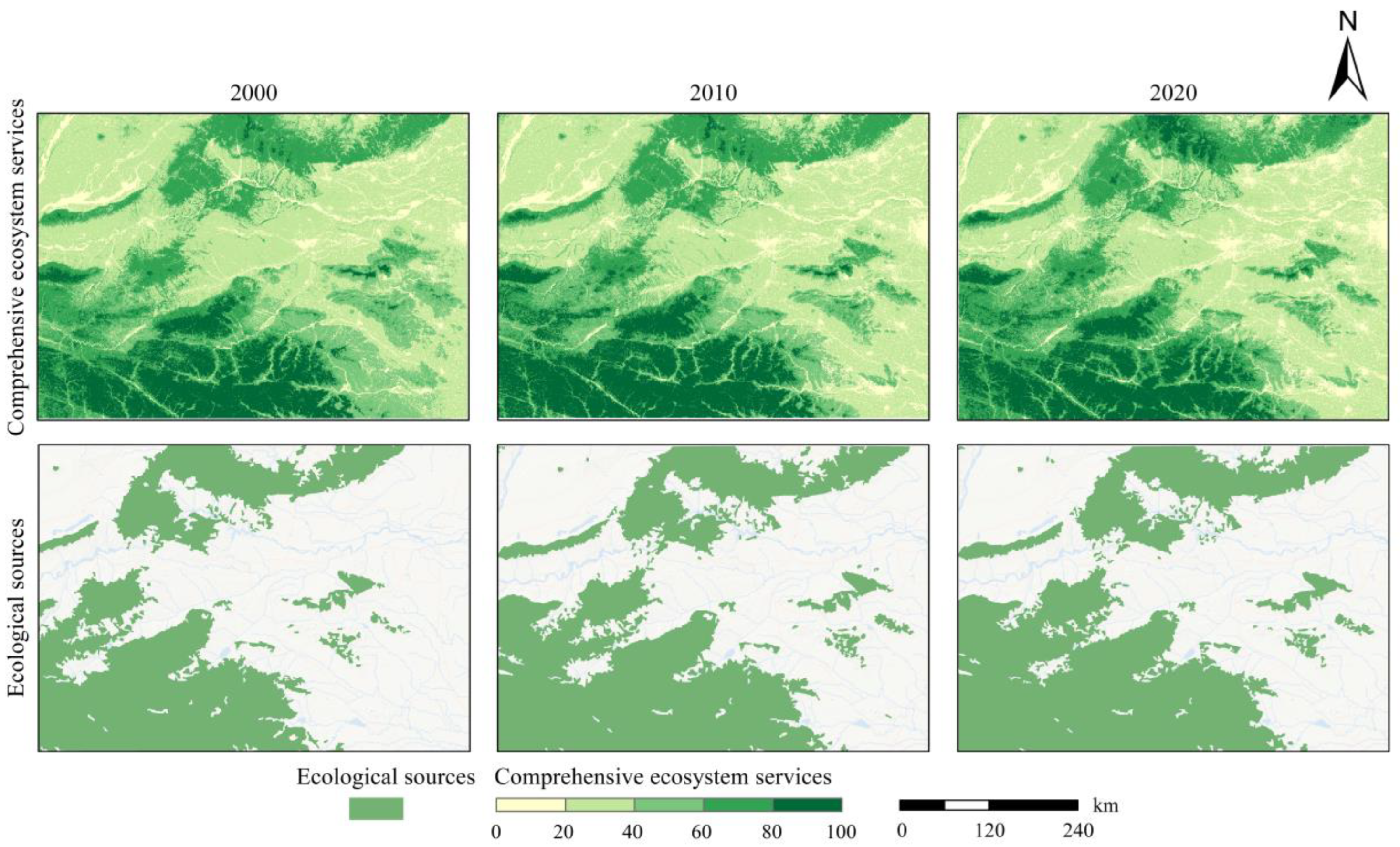
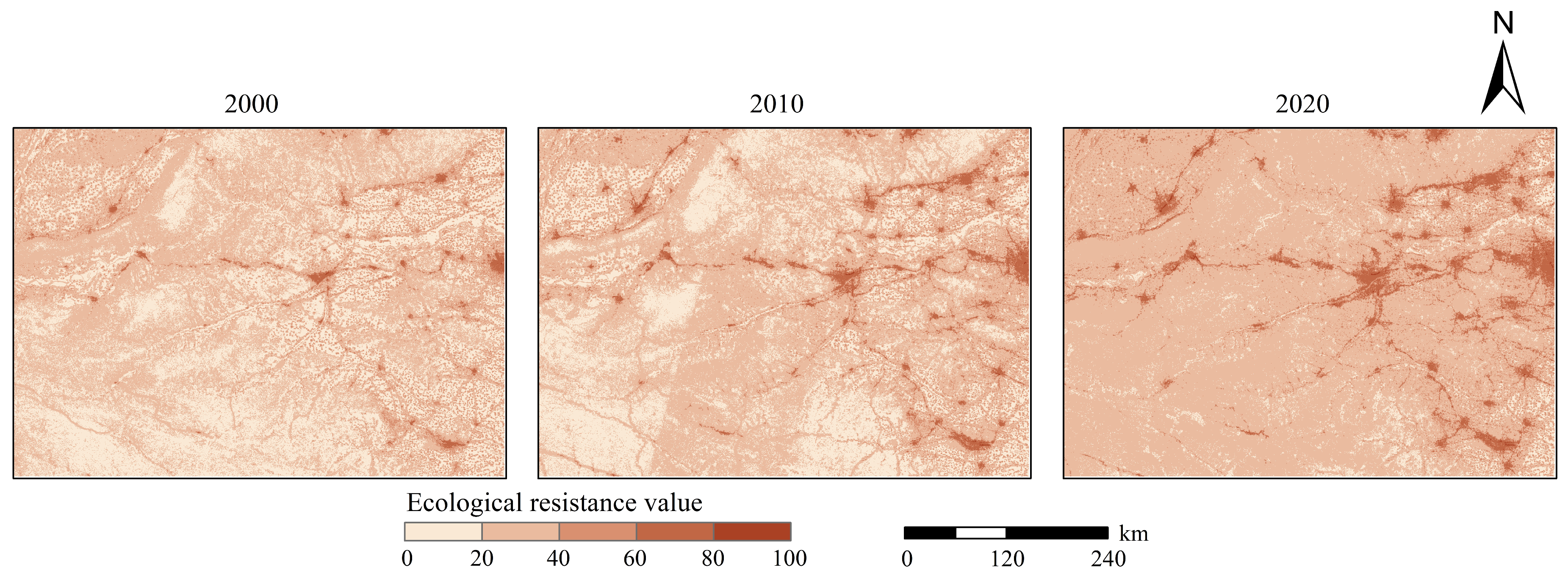
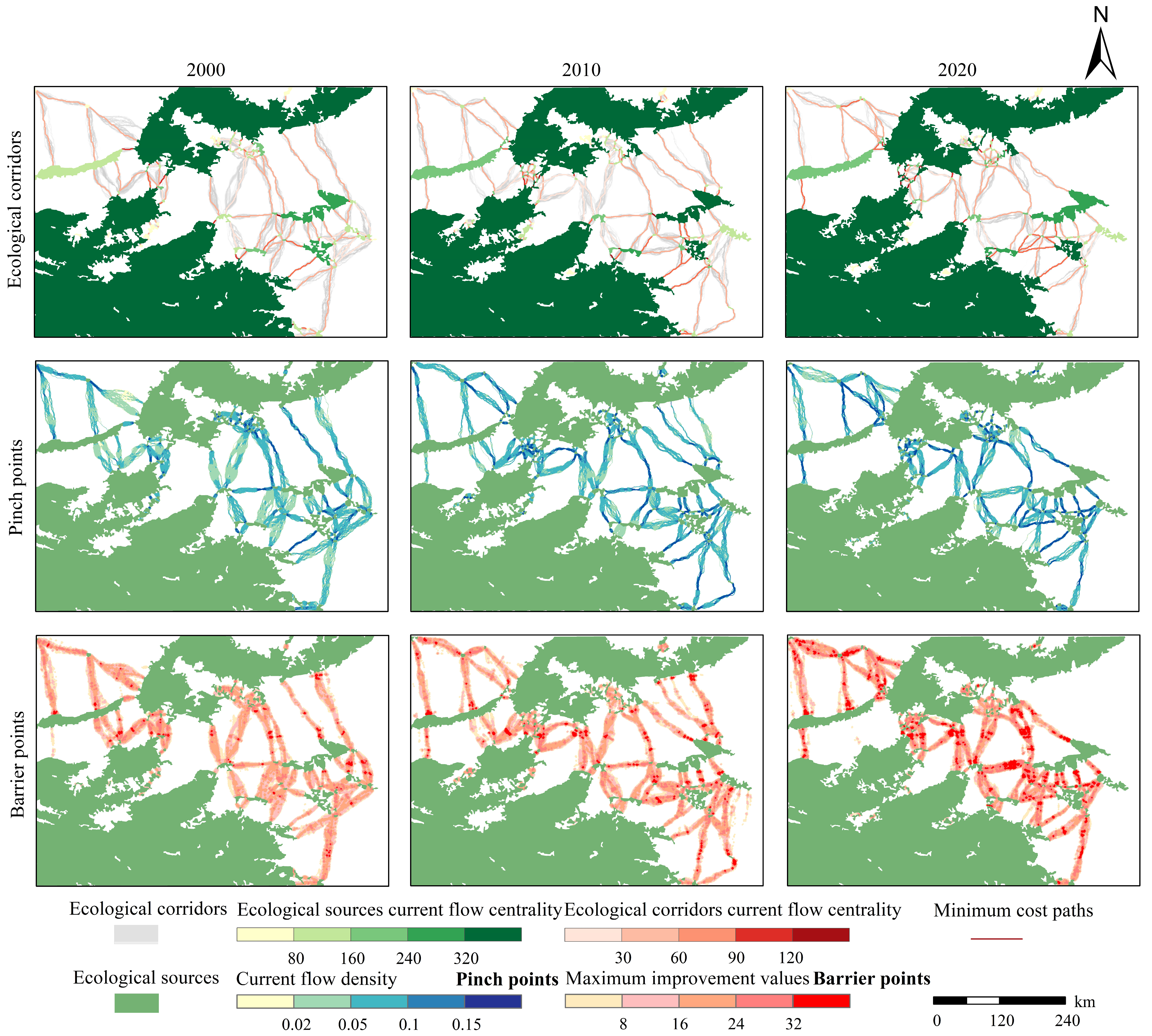
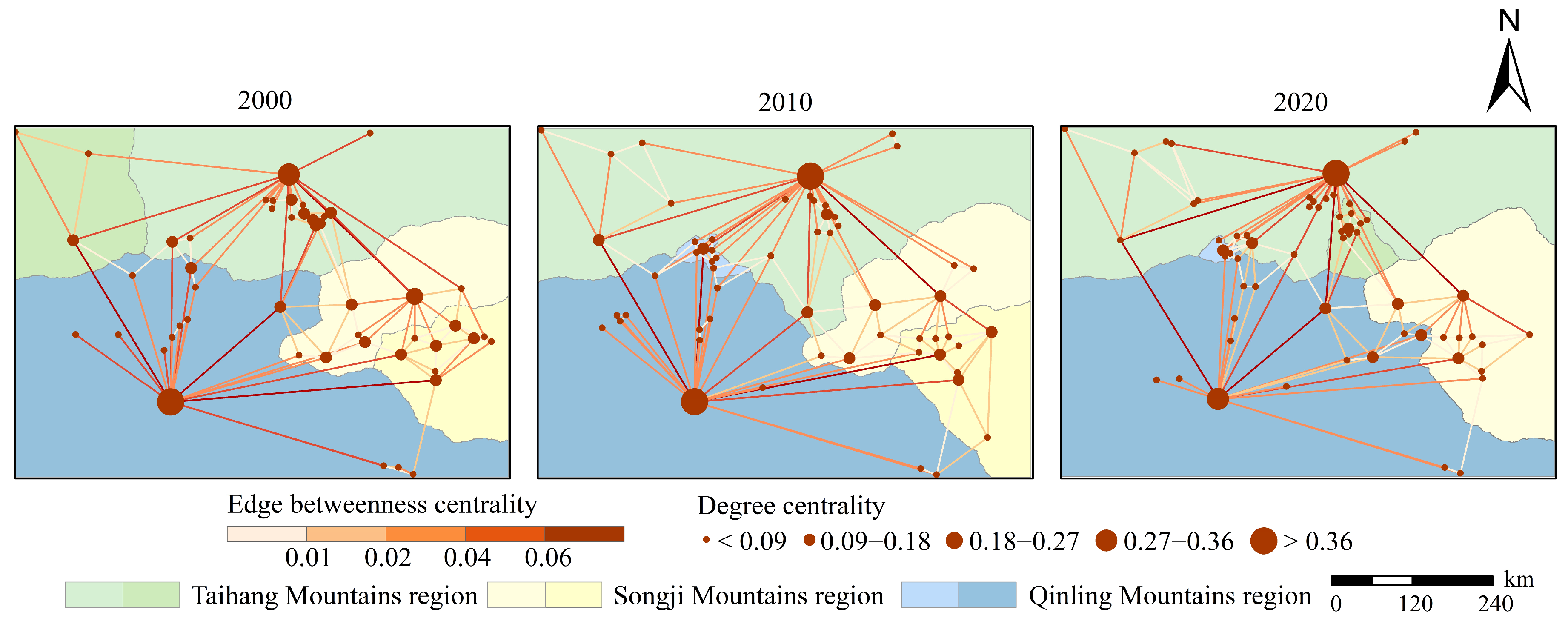

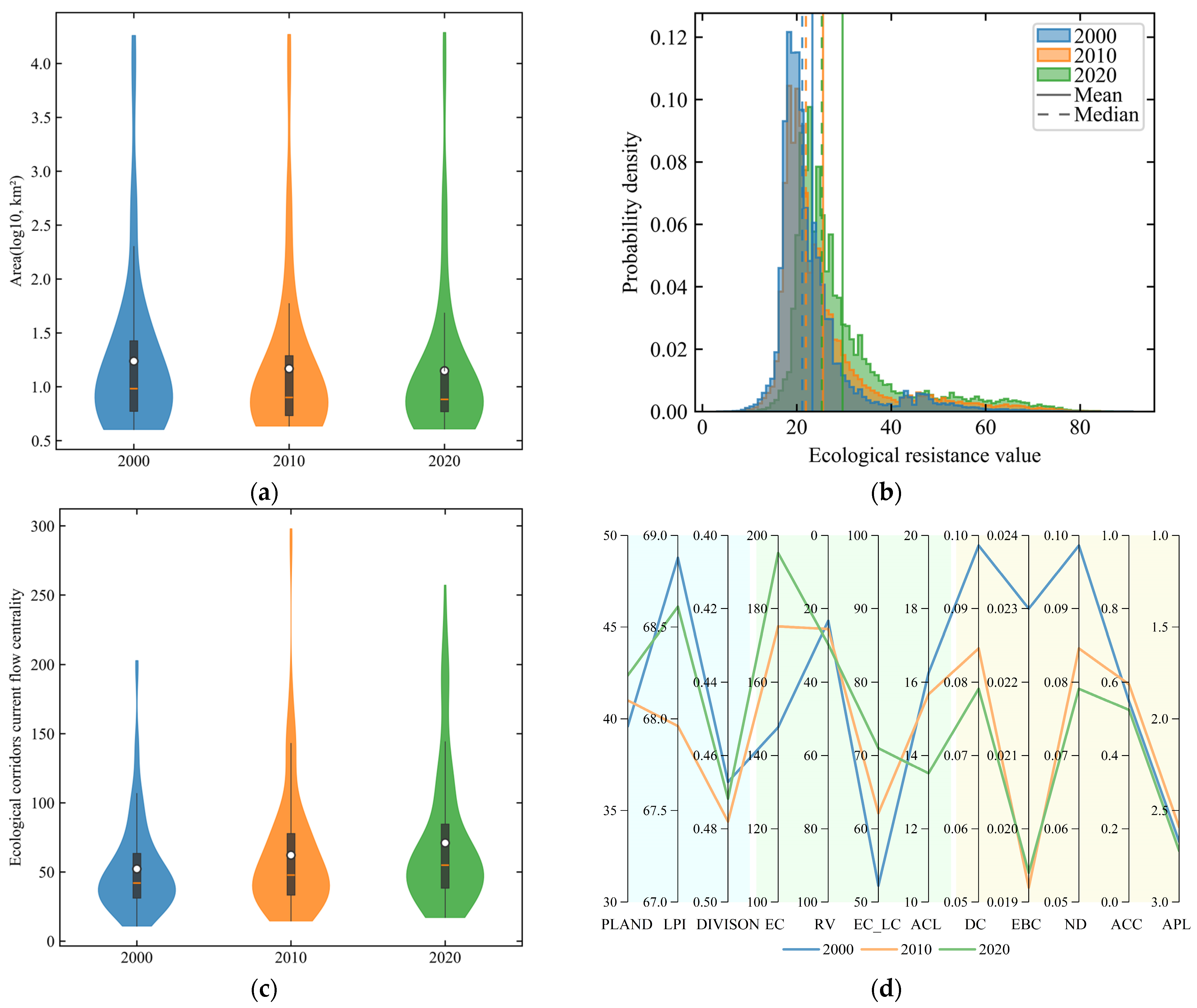
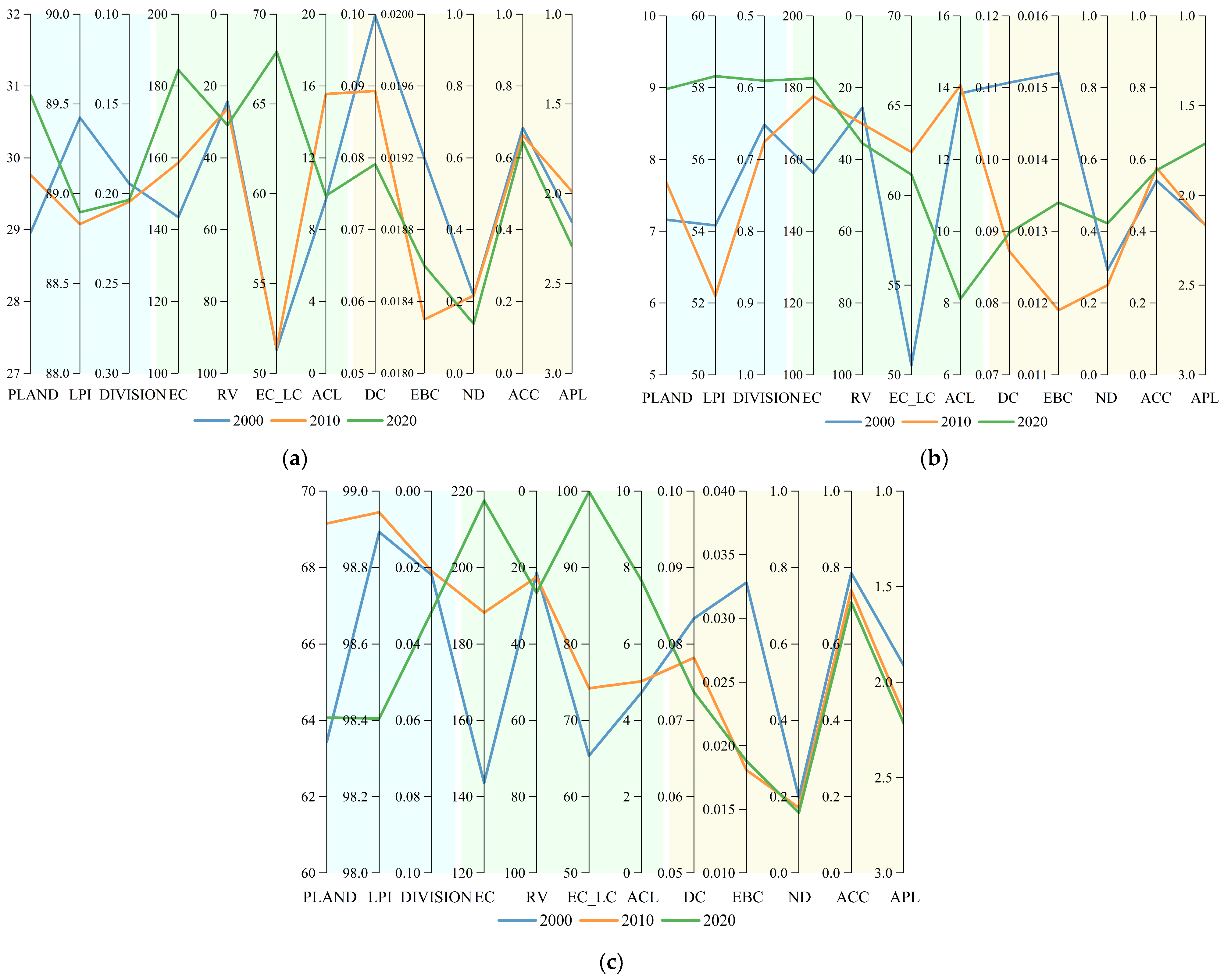
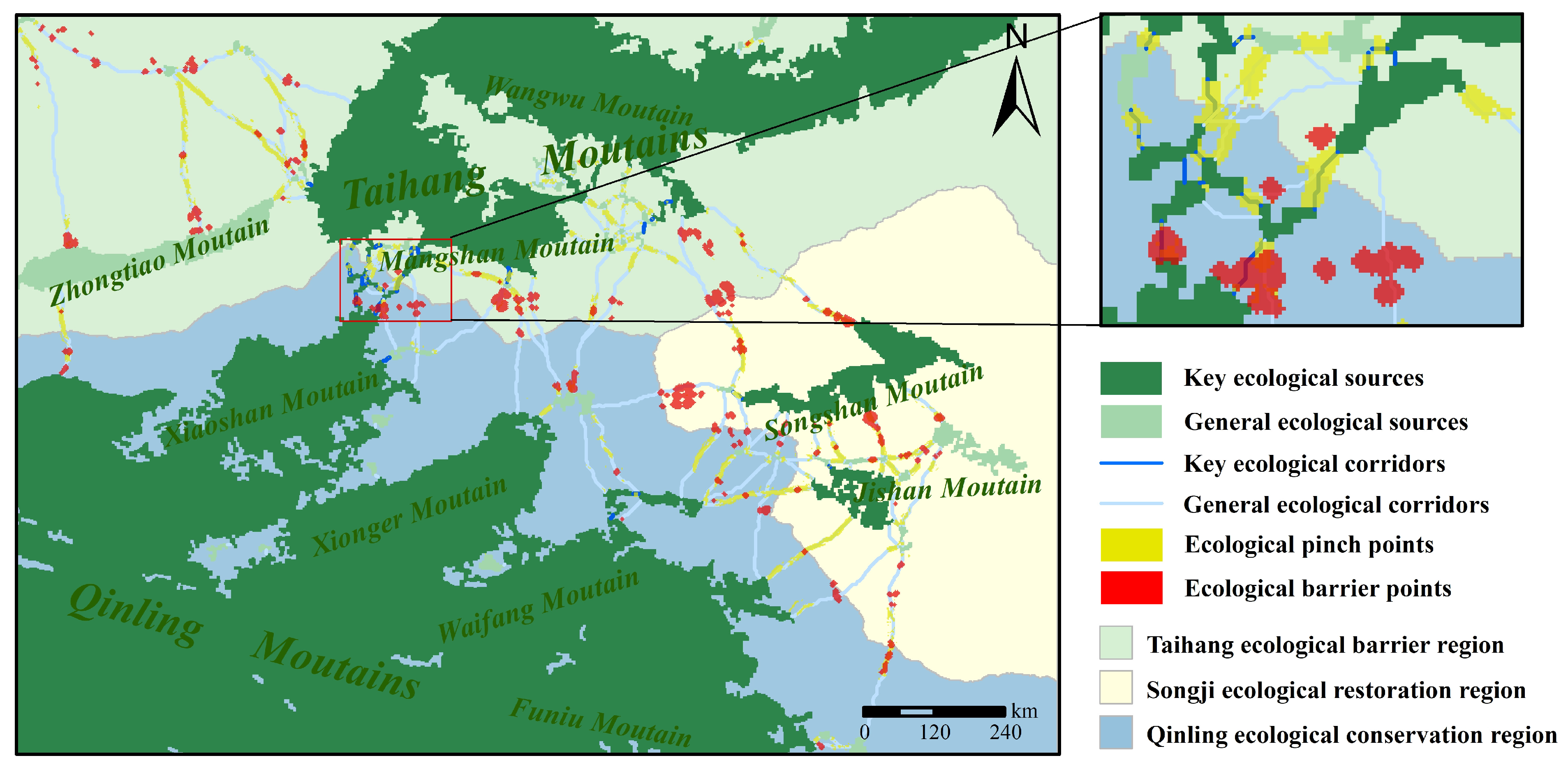
| Factor | Weight | Attribute | Formula |
|---|---|---|---|
| Habitat quality | 0.25 | + | |
| Annual water yield | 0.25 | + | |
| Sediment delivery ratio | 0.25 | + | |
| Carbon storage and sequestration | 0.25 | + |
| Factor | Weight | Resistance Value | |||||
|---|---|---|---|---|---|---|---|
| 1 | 20 | 30 | 40 | 80 | 100 | ||
| Elevation (m) | 0.0458 | <100 | 100–300 | - | 300–600 | 600–1200 | ≥1200 |
| Slope (°) | 0.0536 | <5 | 5–15 | - | 15–25 | 25–35 | ≥35 |
| Topographic relief (m) | 0.0536 | <25 | 25–50 | - | 50–75 | 75–100 | ≥100 |
| Land use type | 0.2200 | Forest, Grassland, Shrub | Cropland | Barren | Water | - | Impervious |
| NDVI | 0.1439 | >0.8 | 0.6–0.8 | - | 0.4–0.6 | 0.2–0.4 | ≤0.2 |
| Distance from waters (m) | 0.0664 | ≤300 | 300–600 | - | 600–900 | 900–1200 | >1200 |
| Nighttime lights | 0.1278 | <10 | 10–20 | - | 20–40 | 40–50 | ≥50 |
| Distance from settlements (m) | 0.1056 | >1000 | 750–1000 | - | 500–750 | 250–500 | ≤250 |
| Distance from roads (m) | 0.0820 | >1000 | 750–1000 | - | 500–750 | 250–500 | ≤250 |
| Distance from railways (m) | 0.1012 | >1000 | 750–1000 | - | 500–750 | 250–500 | ≤250 |
| Type | Factor | Attribute | Meaning |
|---|---|---|---|
| Landscape pattern factors | Patch area percentage (PLAND) | + | The proportion of patch area to total landscape area |
| Largest patch index (LPI) | + | The proportion of the largest patch area to the total landscape area | |
| Division index (DIVISION) | − | The patch fragmentation degree in the landscape | |
| Ecological network basic factors | Ecological sources’ current centrality (EC) | + | The importance of ecological sources in the ecological flow |
| Ecological resistance value (RV) | − | The resistance degree of landscape units to ecological processes | |
| Ecological corridor current centrality (EC_LC) | + | The key role of ecological corridors in ecological networks | |
| Average corridor length (ACL) | + | The average length of all corridors in the ecosystem | |
| Ecological network topological factors | Degree centrality (DC) | + | The connection degree of nodes in the network |
| Edge betweenness centrality (EBC) | + | The strength of the mediating role of the edge in the network | |
| Network density (ND) | + | Ratio of actual to maximum possible connections | |
| Average clustering coefficient (ACC) | + | The agglomeration degree of network nodes | |
| Average path length (APL) | − | The average of the shortest paths between any two nodes in the network |
| Data | Name | Source | Resolution |
|---|---|---|---|
| Digital elevation model | Copernicus DEM dataset | European Space Agency | 30 m |
| Land use type | China land cover products | Wuhan University Institute of Remote Sensing Information Processing | 30 m |
| Nighttime lights | Annual dataset of nighttime lights in China | Resource and Environmental Science and Data Center, Institute of Geographic Sciences and Natural Resources Research, Chinese Academy of Sciences | 1 km |
| NDVI | The largest annual NDVI dataset in China | National Ecological Science Data Center | 30 m |
| annual rainfall | Annual precipitation dataset in China | National Earth System Science Data Centers | 1 km |
| Monthly rainfall | Monthly precipitation dataset in China | National Earth System Science Data Centers | 1 km |
| Potential evapotranspiration | Monthly potential evapotranspiration dataset for China | National Earth System Science Data Centers | 1 km |
| Root restricting layer depth | Absolute depth to bedrock | World Soil Information Data Center | 250 m |
| Plant available water content | Derived available soil water capacity (volumetric fraction) until wilting point | World Soil Information Data Center | 250 m |
| Soil | Harmonized World Soil Database v2.0 | Food and Agriculture Organization of the United Nations | 1 km |
Disclaimer/Publisher’s Note: The statements, opinions and data contained in all publications are solely those of the individual author(s) and contributor(s) and not of MDPI and/or the editor(s). MDPI and/or the editor(s) disclaim responsibility for any injury to people or property resulting from any ideas, methods, instructions or products referred to in the content. |
© 2025 by the authors. Licensee MDPI, Basel, Switzerland. This article is an open access article distributed under the terms and conditions of the Creative Commons Attribution (CC BY) license (https://creativecommons.org/licenses/by/4.0/).
Share and Cite
Chen, Y.; Li, J.; Ye, Q.; Zhang, S.; Meng, X.; Chen, W.; Ji, G.; He, W.; Wei, H.; Guo, L. An Evaluation Framework for Regional Ecological Security Pattern Quality: A Case Study of the Taihang–Qinling Intersection Zone, China. Land 2025, 14, 1706. https://doi.org/10.3390/land14091706
Chen Y, Li J, Ye Q, Zhang S, Meng X, Chen W, Ji G, He W, Wei H, Guo L. An Evaluation Framework for Regional Ecological Security Pattern Quality: A Case Study of the Taihang–Qinling Intersection Zone, China. Land. 2025; 14(9):1706. https://doi.org/10.3390/land14091706
Chicago/Turabian StyleChen, Yihao, Jiwei Li, Qingqing Ye, Shuai Zhang, Xiaojiao Meng, Weiqiang Chen, Guangxing Ji, Weikang He, Hejie Wei, and Long Guo. 2025. "An Evaluation Framework for Regional Ecological Security Pattern Quality: A Case Study of the Taihang–Qinling Intersection Zone, China" Land 14, no. 9: 1706. https://doi.org/10.3390/land14091706
APA StyleChen, Y., Li, J., Ye, Q., Zhang, S., Meng, X., Chen, W., Ji, G., He, W., Wei, H., & Guo, L. (2025). An Evaluation Framework for Regional Ecological Security Pattern Quality: A Case Study of the Taihang–Qinling Intersection Zone, China. Land, 14(9), 1706. https://doi.org/10.3390/land14091706








